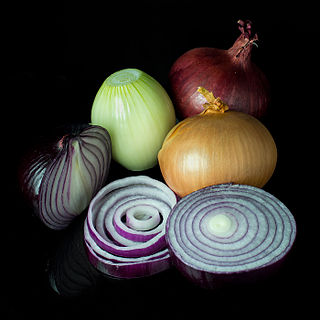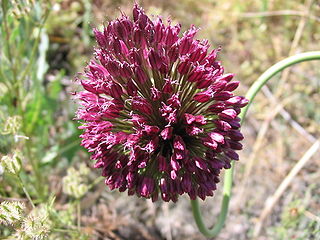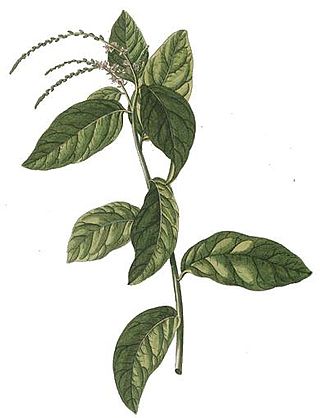
Chives, scientific name Allium schoenoprasum, is a species of flowering plant in the family Amaryllidaceae that produces edible leaves and flowers. Their close relatives include the common onions, garlic, shallot, leek, scallion, and Chinese onion.

An onion, also known as the bulb onion or common onion, is a vegetable that is the most widely cultivated species of the genus Allium. The shallot is a botanical variety of the onion which was classified as a separate species until 2011. Its close relatives include garlic, scallion, leek, and chive.

Allicin is an organosulfur compound obtained from garlic. When fresh garlic is chopped or crushed, the enzyme alliinase converts alliin into allicin, which is responsible for the aroma of fresh garlic. Allicin is unstable and quickly changes into a series of other sulfur-containing compounds such as diallyl disulfide. Allicin is an antifeedant, i.e. the defense mechanism against attacks by pests on the garlic plant.

Allium ursinum, known as wild garlic, ramsons, cowleekes, cows's leek, cowleek, buckrams, broad-leaved garlic, wood garlic, bear leek, Eurasian wild garlic or bear's garlic, is a bulbous perennial flowering plant in the amaryllis family Amaryllidaceae. It is native to Europe and Asia, where it grows in moist woodland. It is a wild relative of onion and garlic, all belonging to the same genus, Allium. There are two recognized subspecies: A. ursinum subsp. ursinum and A. ursinum subsp. ucrainicum.

Allium sphaerocephalon is a plant species in the Amaryllis family known as round-headed leek, round-headed garlic, ball-head onion, and other variations on these names. Drumstick allium is another common name applied to this species. Some publications use the alternate spelling Allium sphaerocephalum. It is a bulbous herbaceous perennial plant.

Primula matthioli, synonym Cortusa matthioli, sometimes called alpine bells, is a flowering plant with a wide distribution in the Palearctic, both in Europe and in temperate Asia, from Siberia in the north to Afghanistan, Pakistan and China in the south.

In chemistry, a sulfenic acid is an organosulfur compound and oxoacid with the general formula R−S−OH. It is the first member of the family of organosulfur oxoacids, which also include sulfinic acids and sulfonic acids, respectively. The base member of the sulfenic acid series with R = H is hydrogen thioperoxide.

Petiveria is a genus of flowering plants in the pigeonberry family, Petiveriaceae. The sole species it contains, Petiveria alliacea, is native to Florida and the lower Rio Grande Valley of Texas in the United States, Mexico, Central America, the Caribbean, and tropical South America. Introduced populations occur in Benin and Nigeria. It is a deeply rooted herbaceous perennial shrub growing up to 1 m (3.3 ft) in height and has small greenish piccate flowers. The roots and leaves have a strong acrid, garlic-like odor which taints the milk and meat of animals that graze on it.

syn-Propanethial S-oxide (or (Z)-propanethial S-oxide), a member of a class of organosulfur compounds known as thiocarbonyl S-oxides (formerly "sulfines"), is a volatile liquid that acts as a lachrymatory agent (triggers tearing and stinging on contact with the eyes). The chemical is released from onions, Allium cepa, as they are sliced. The release is due to the breaking open of the onion cells and their releasing enzymes called alliinases, which then break down amino acid sulfoxides, generating sulfenic acids. A specific sulfenic acid, 1-propenesulfenic acid, formed when onions are cut, is rapidly rearranged by a second enzyme, called the lachrymatory factor synthase or LFS, giving syn-propanethial S-oxide. The gas diffuses through the air and, on contact with the eye, it stimulates sensory neurons creating a stinging, painful sensation. Tears are released from the tear glands to dilute and flush out the irritant. A structurally related lachrymatory compound, syn-butanethial S-oxide, C4H8OS, has been found in another genus Allium plant, Allium siculum.

Allium moly, also known as yellow garlic, golden garlic and lily leek, Is a species of flowering plant in the genus Allium, which also includes the flowering and culinary onions and garlic. A bulbous herbaceous perennial from the Mediterranean, it is edible and also used as a medicinal and ornamental plant.

In enzymology, an alliin lyase is an enzyme that catalyzes the chemical reaction

In organosulfur chemistry, thiosulfinate is a functional group consisting of the linkage R-S(O)-S-R. Thiolsulfinates are also named as alkanethiosulfinic acid esters.

Allium tuncelianum is a species of wild onion which is endemic to the Munzur Valley in Tunceli, in eastern Turkey.It usually produces a single-bulb white onion, unlike garlic, which has multiple bulbs. It has a garlic odor and taste and is used locally like garlic. Its common names include Tunceli garlic and Ovacik garlic. Botanists have suggested this species may be a close relative of garlic, and perhaps an ancestor of garlic, but genetic analysis shows that it is actually more closely related to leek. The plant is collected from the wild for use in cooking, a phenomenon that threatens the plant with extinction. It is known that Tunceli garlic shows higher antiradical activity and contains more total phenolic compounds than normal garlic. In addition, it is possible to say that Tunceli garlic is a better natural antioxidant than Kastamonu garlic. Tunceli garlic is single-toothed, has small tooth-like formations between its shells, has the familiar taste and aroma of garlic, unlike others, it can flower and give seeds. It has a chance to be used in consumption as well as in industry, due to its features such as being single-toothed, the number of shells being less compared to the cultivated garlic, and the storage of the head parts. It is stored for a long time at 18-20"C. It is collected from the mountains in the region and sold under the name of 'Rock garlic' and used as commercial goods. In an experiment conducted at Malatya Turgut Özal University, the effect of intraperitoneal injection of 1% and 10% doses of Tunceli garlic oil on some immunological factors of rainbow trout was evaluated. Rohu pups were fed a garlic supplemented diet for 60 days. This fish was then exposed to Aeromonas hydrophila by IP injection. Rainbow trout fry were fed garlic to groups for 14 days prior to intraperitoneal injection challenge with Aeromonas hydrophila per fish. In both of these studies, it was noted that fish fed garlic showed increased serum lysozyme and bactericidal activities and higher serum total protein.

Allium stipitatum, Persian shallot, is an Asian species of onion native to central and southwestern Asia.

Allium carinatum, the keeled garlic or witch's garlic, is a bulbous perennial flowering plant in the family Amaryllidaceae. It is widespread across central and southern Europe, with some populations in Asiatic Turkey. It is cultivated in many places as an ornamental and also for its potently aromatic bulbs used as a food flavoring.

Allium flavum, the small yellow onion or yellow-flowered garlic, is a species of flowering plant in the genus Allium. A bulbous herbaceous perennial, it is native to the lands surrounding the Mediterranean, Black, and Caspian Seas, from France + Morocco to Iran + Kazakhstan.

Allium pallens is a species of wild onion native to the Mediterranean region and Middle East from Portugal and Algeria to Iran.
Allium tripedale is a species of wild onion native to the Caucasus, Iraq, Turkey, and northern Iran. It is related to Allium siculum. It produces up to 30 pink-violet bell-shaped flowers per umbel.

Allium subhirsutum, the hairy garlic, is a plant species widespread around the Mediterranean region from Spain and the Canary Islands to Turkey and Palestine.
The precise taxonomy of the genus Allium is still poorly understood with incorrect descriptions being widespread. With over 850 species distributed over the Northern hemisphere Allium is the sole genus in the Allieae, one of four tribes of subfamily Allioideae (Amaryllidaceae). New species continue to be described and Allium is both highly variable and one of the largest monocotyledonous genera, but the precise taxonomy of Allium is poorly understood, with incorrect descriptions being widespread. The difficulties arise from the fact that the genus displays considerable polymorphism and has adapted to a wide variety of habitats. Furthermore, traditional classications had been based on homoplasious characteristics. However, the genus has been shown to be monophyletic, containing three major clades, although some proposed subgenera are not. Some progress is being made using molecular phylogenetic methods, and the internal transcribed spacer (ITS) region, including the 5.8S rDNA and the two spacers ITS1 and ITS2, is one of the more commonly used markers in the study of the differentiation of the Allium species.



















